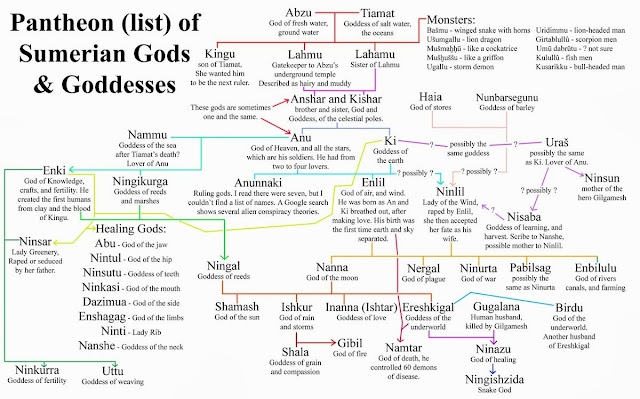Ø
This myth starts with a vast
ocean. There’s something about water that suggests eternity, so Sumerians
believed it must have always existed, before land, skies, stars, or the sun.
There were two gods of water, Abzu, of fresh water, and his wife Tiamat,
goddess of the wild salt water seas. By combining their waters, they created
the first life.
Ø
They had a son named Kingu,
whom they loved dearly. But, they treated their next children, Lahmu and
Lahamu, like servants, standing watch at the gate of their temple, which I
suppose was underwater?
Ø
Lahmu and Lahamu fell in love
and had children. It may sound strange, but Sumerians thought of their gods as
forces of nature, not as a human family. Besides, they didn’t have any other
options, they were all that existed in the world.
Ø
These two gave birth to Anshar,
god of the heavenly pole, and Kishar, goddess of the earthly pole. Their births
created the heavens and the earth. Note this was never planned for nor
appreciated by Abzu or Tiamat. They were quite content with the oceans.
Ø
Anshar and Kishar also fell in
love, as spiritual opposites who balanced one another, so they had children of
their own, Anu and Ki. Now, this is confusing because sometimes these parents
and kids were different gods, and sometimes they were the same. Anshar was Anu,
and Kishar was Ki. They had a limited vocabulary back then, with some words
having double meanings.
Ø
Anyway, skipping that, Anu was
god of the heavens, and Ki was goddess of the earth. They also fell in love,
big surprise, and gave birth to the Anunnaki, the senior gods of Sumeria, led
by their firstborn Enlil, god of air and wind. Anu also created the stars to be
his soldiers.
Ø
Anu and Ki had a falling out,
for some reason. It may have had to do with the birth of Enlil, causing the
creation of air, which separated earth and the heavens for the first time. Who
knows? But, Anu fell in love with another goddess named Nammu (we don’t know
much of her origins, but she was kind). They had two children, Ningikurga and Enki, god of knowledge.
Ø
Now, here’s where the story
gets interesting. Enlil created a new line of lesser gods called Igigi, similar
to angels, to work the land, and keep the world in order. They rebelled, much
like Lucifer, and the chaos they started awoke Abzu. He figured he’d just kill
all the gods and goddesses of this story, and go back to sleep. But, Enki
somehow lulled Abzu back to sleep and then trapped him in Kur, the land of the
dead. Enki then took his powers of water to become god of fertility.
Ø
That stopped Abzu, but his wife
Tiamat was enraged. She created a host of monsters to kill the gods. Now, who
killed Tiamat? It depends on which tablet you translate. It may have been
Enlil, or Babylonian Marduk, or Assyrian Asshur, or Nergal. Whichever hero did
it, they killed Tiamat, and used her body to maintain order in the universe.
Her ribs hold up the sky. Her tail is now the Milky Way, and her crying eyes
were used as sources for the Tigris and Euphrates
river.
Ø
This saved the gods from death,
but there was still the question of who would replace the Igigi? Here’s where
we have to thank Enki. He got the idea of making the first humans out of clay.
There was just one problem. They needed blood. Here the gods all got together
and decided to kill Kingu, the last remaining threat to their existence, using
his blood. Enki didn’t like it, but in the end he agreed and we were born!
That’s why we have to work. We were chosen by the gods to take care of the
world for them.
Ø
Now, just like Abzu didn’t
approve being awoken, Enlil hated how noisy people were, so he came up with
ways to kill us – drought, famine, and plagues. Each time, Enki would save us,
and each time Enlil got angrier. Finally, he tried to wipe us out with a flood.
Enki told the Sumerian king Atraharsis to build an ark for his family, and fill
it with every kind of animal. He did this and saved his family just as the
flood started. After a week, they found dry ground and start over again. Enlil
was furious, but Enki got him to agree with new laws limiting population
growth. I assume this story was used to justify the killing of children to
control a city’s population, which was common practice in those days.








+web.jpg)














